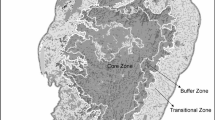Abstract
Landscape and climatic changes in northwestern Altai at the end of the Middle Pleistocene were accompanied by a transformation in the taxonomic composition of the bat community and abundance of some species. The dynamics of the bat community is very important for the study of the activity of Paleolithic man. The high sensitivity of bats to human disturbance allowed the time of colonization and nature of usage of Denisova cave by humans to be recognized. In this respect, bats are a very important indicator of events in the surrounding ecosystem.
Similar content being viewed by others
References
A. K. Agadjanian, “The Late Pleistocene Mammals of Northwestern Altai in Conditions of Paleolithic Man Activity,” in Modern Archeozoological Investigations in Russia (Moscow, 2003), pp. 81–115 [in Russian].
A. K. Agadjanian, “The Small Mammal Fauna of Denisova cave,” in Problems of Archeology, Ethnography, and Anthropology of Siberia and Adjacent Territories (Inst. Arkheol. Etnogr. Sib. Otd. Ross. Akad. Nauk, Novosibirsk, 1998), Vol. 1, pp. 34–41 [in Russian].
R. Arlettaz, M. Ruedi, and J. Hausser, “Ecologie trophique de deux especes jumelles et sympatriques de chauves-souris: Myotis myotis et Myotis blythi (Chiroptera: Vespertilionidae), Premiers resultants,” Mammalia 57(4), 519–531 (1993).
G. F. Baryshnikov, “Paleoecology of the Most Ancient Inhabitants of the Altai Mountains,” in Problems of Archeology, Ethnography, and Anthropology of Siberia and Adjacent Territories (Inst. Arkheol. Etnogr. Sib. Otd. Ross. Akad. Nauk, Novosibirsk, 1998), Vol. 1, pp. 42–50 [in Russian].
T. A. Dupal, “Changes in Small Mammal Communities of the Northwestern Altai at the Pleistocene-Holocene Boundary,” Paleontol. Zh., No. 1, 78–84 (2004) [Paleontol. J. 38 (1), 83–89 (2004)].
E. M. Malaeva, “Palinology of Pleistocene Deposits of nearby Entrance of Denisova Cave,” in Problems of Archeology, Ethnography, and Anthropology of Siberia and Adjacent Territories (Inst. Arkheol. Etnogr. Sib. Otd. Ross. Akad. Nauk, Novosibirsk, 1998), Vol. 5, pp. 163–168 [in Russian].
Author information
Authors and Affiliations
Rights and permissions
About this article
Cite this article
Rossina, V.V. Bats as an indicator of human activity in the paleolithic, using the example of denisova cave, northwestern Altai. Paleontol. J. 40, S494–S500 (2006). https://doi.org/10.1134/S0031030106100091
Received:
Issue Date:
DOI: https://doi.org/10.1134/S0031030106100091




